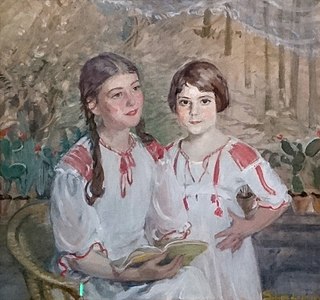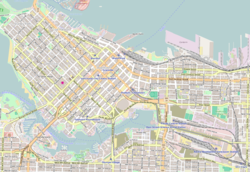
The John Hancock Center is a 100-story, 1,128-foot supertall skyscraper located in Chicago, Illinois. Located in the Magnificent Mile district, the building was officially renamed 875 North Michigan Avenue in 2018.
Arthur Charles Erickson was a Canadian architect and urban planner. He studied Engineering at the University of British Columbia and, in 1950, received his B.Arch. (Honours) from McGill University. He is known as Canada's most influential architect and was the only Canadian architect to win the American Institute of Architects AIA Gold Medal. When told of Erickson's award, Philip Johnson said, "Arthur Erickson is by far the greatest architect in Canada, and he may be the greatest on this continent."

The Vancouver Art Gallery (VAG) is an art museum in Vancouver, British Columbia, Canada. The museum occupies a 15,300-square-metre-building (165,000 sq ft) adjacent to Robson Square in downtown Vancouver, making it the largest art museum in Western Canada by building size. Designed by Francis Rattenbury, the building the museum occupies was originally opened as a provincial courthouse, before it was re-purposed for museum use in the early 1980s. The building was designated the Former Vancouver Law Courts National Historic Site of Canada in 1980.

Roy Thomson Hall is a concert hall in Toronto, Ontario, Canada. Located downtown in the city's entertainment district, it is home to the Toronto Symphony Orchestra, the Toronto Mendelssohn Choir, and the Toronto Defiant. Opened in 1982, its circular architectural design exhibits a sloping and curvilinear glass exterior. It was designed by Canadian architects Arthur Erickson and Mathers and Haldenby. Itzhak Perlman acted as a special advisor to the architects on accessibility needs for disabled performers and guests.

Campus Martius Park is a re-established park in Downtown Detroit, Michigan. After the fire of 1805, Campus Martius was the focal point of Judge Augustus Woodward's plans to rebuild the city. It was named for the principal square in Marietta, Ohio, the first capital of the Northwest Territories.

PPG Place is a complex in downtown Pittsburgh, Pennsylvania, consisting of six buildings within three city blocks and five and a half acres. PPG Place was designed by architects Philip Johnson and John Burgee.

Cornelia Hahn Oberlander LL.D. was a German-born Canadian landscape architect. Her firm, Cornelia Hahn Oberlander Landscape Architects, was founded in 1953, when she moved to Vancouver.

The architecture of Canada is, with the exception of that of Canadian First Nations, closely linked to the techniques and styles developed in Canada, Europe and the United States. However, design has long needed to be adapted to Canada's climate and geography, and at times has also reflected the uniqueness of Canadian culture.

The Richmond Olympic Oval is an indoor multi-sports arena in the Canadian city of Richmond, British Columbia. The oval was built for the 2010 Winter Olympics and was originally configured with a speed skating rink. The venue has since been reconfigured and now serves as a community multi-sport park and includes two ice hockey rinks, two running tracks, a climbing wall, a rowing tank and a flexible area which can be used for, among other sports, basketball, volleyball, indoor soccer and table tennis.

Vancouver City Centre is an underground station on the Canada Line of Metro Vancouver's SkyTrain rapid transit system. The station is located on Granville Street, between West Georgia Street and Robson Street in Downtown Vancouver, and serves the shopping and entertainment districts along Granville and Robson streets, and the office and shopping complexes of Pacific Centre and Vancouver Centre.

Bing Wing Thom, was a Canadian architect and urban designer. Born in Hong Kong, he immigrated to Vancouver, British Columbia, Canada with his family in 1950. His paternal grandfather originally immigrated to Vancouver in the 1890s and his father was born in New Westminster before moving to Hong Kong after being unable to practice as a pharmacist in Canada.

The architecture of Houston includes a wide variety of award-winning and historic examples located in various areas of the city of Houston, Texas. From early in its history to current times, the city inspired innovative and challenging building design and construction, as it quickly grew into an internationally recognized commercial and industrial hub of Texas and the United States.

One Bayfront Plaza is a proposed supertall skyscraper in Miami, Florida, U.S. The building, construction of which has been approved, would stand at 1,049 feet (320 m), with 93 floors, becoming the tallest building in Miami and Florida. One Bayfront Plaza would primarily consist of offices and hotel space, but also would include a retail mall, condominiums, and parking garage on the lower levels, as well as possibly an observation deck at the top. The entire project consists of over 1,400,000 square feet (100,000 m2) of Class A office and hotel space, as well as a total building area of over 4,000,000 square feet (371,612 m2) including the large podium. One Bayfront Plaza is the first skyscraper over 1,000 feet (305 m) to be approved for construction in Miami. The building's primary advocate is real estate developer Tibor Hollo, who has won several awards for his 55 years as a developer in Miami, and is currently the president of Florida East Coast Realty.

Pennzoil Place is a set of two 36-story towers in Downtown Houston, United States. designed by Philip Johnson/John Burgee Architects from a concept by Eli Attia, a staff architect with the firm. Completed in 1976, it is Houston's most award-winning skyscraper and is widely known for its innovative design.

The Wayne Lyman Morse United States Courthouse is a federal courthouse located in Eugene, Oregon. Completed in 2006, it serves the District of Oregon as part of the Ninth Judicial Circuit. The courthouse is named in honor of former U.S. Senator Wayne Morse who represented Oregon for 24 years in the Senate and was a Eugene area resident. Located in downtown Eugene, the building overlooks the Willamette River.

The Law Courts building is part of the landmark Robson Square complex in downtown Vancouver, British Columbia, Canada. It was designed by renowned Canadian architect Arthur Erickson. The Law Courts building occupies the southern block of the three city block complex, provincial government offices the middle block, and the Vancouver Art Gallery the northern block. The building is used exclusively by the two higher courts of the Province of British Columbia: the Supreme Court and the Court of Appeal.

Robert Arthur Williams is a consultant and political figure in British Columbia. He represented Vancouver East in the Legislative Assembly of British Columbia from 1966 to 1976 and from 1984 to 1991 as a New Democratic Party (NDP) member.

The architecture of Vancouver and the Greater Vancouver area consists of a variety of modern architectural styles, such as the 20th-century Edwardian style and the 21st-century modernist style. Initially, the city architects embraced styles and ideas developed in Europe and the United States, with only limited local variation.
Eva Matsuzaki is a retired architect and first former female president of the Royal Architectural Institute of Canada (RAIC). Eva immigrated from Latvia to the United States and later developed her career living in Vancouver, Canada. In 1998, she established her own firm known as Matsuzaki Architects Incorporated along with her husband, Kiyoshi Matsuzaki. Matsuzaki is a founding member of Vancouver's women in architecture support network and is involved in environmentally sensitive and sustainable building design.

Geoffrey Massey was a Canadian architect and urban planner noted for his modernism-inspired architectural works. He was known for his partnership with architect Arthur Erickson that produced notable designs including the Simon Fraser University, and MacMillan Bloedel Building. As an urban planner, Massey was known for his contributions toward pedestrian-friendly densification of Vancouver and development of Granville Island in the city.
























